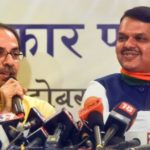‘…that it takes fantasy seriously as a part of real life.’
A fascinating excerpt from Jonathan Gil Harris’s book, Masala Shakespeare: How A Firangi Writer Became Indian.
IMAGE: Gracy Singh and Aamir Khan in Lagaan.
In May 2018, I suddenly lost my house — the house in which I wrote most of this book. The night after my landlady informed me that, due to her marital problems, I would have to vacate the premises within two weeks, a massive storm struck Delhi.
Lightning lit up the whole sky, bathing the forest next to our house in flashes of garish yellow. During each flash I could see the forest’s branches, lashed by the wind and rain, waving frantically as if in helpless despair.
The vision left me feeling as if the forest and I had been cast in some badly adapted version of King Lear. Like that play’s titular character, I had lost my home and was in a storm.
I wasn’t outdoors, exposed to the elements as Shakespeare’s mad king is. But I certainly experienced the storm, and those frantically waving branches, as expressing the thunder in my own helpless heart.
And Mohammed Rafi’s song from the Dharmendra film Loafer (1973), Aaj Mausam Bada Beimaan Hai, began playing in my head:
Aaj Mausam Bada Beimaan Hai… Aane Wala Koi Toofaan Hai
Of course, my response to the storm was an example of that species of individualist megalomania called the Pathetic Fallacy: The idea that inanimate objects express what I’m feeling.
But my reaction to the storm was influenced by more than mere narcissistic projection. It didn’t help that the loss of our house happened just two days before my elderly parents in New Zealand were due to move into an assisted living facility.
My mother’s dementia had left her memory dimmed, my father’s macular degeneration had left him blind, and their combined frailty meant they had no choice but to give up their house.
IMAGE: Mumtaz and Dharmendra in Loafer.
‘Aaj Mausam Bada Beimaan Hai.’
That’s why King Lear, a tragedy that features scenes of old-age madness and blindness as well as the trauma of losing one’s home, was already very much in my mind.
The loss of my own house, and the storm that accompanied it, was emotionally tied up for me with an ominous sense of radical generational shift, of the peeling away of a layer of parental protection that, even many thousands of miles away, I had carried with me all my life like a quilt.
What a difference from nearly twenty years earlier when I encountered my first Bollywood storm in Lagaan. That toofaan was not the corollary of a desperate heart.
Instead, it was a welcome reassurance to an entire community that included Hindu, Muslim, Sikh, and Dalit. It was a reassurance that a long season of misery was now over, that life would be regenerated for all the villagers of Champaner, thanks to the coming of the monsoon.
The rain started to fall after Aamir Khan hit the winning six in their daring match against the English team — as if the rain-gods themselves had approved the Indian victory that would relieve the villagers of the burdens of triple taxation and debt.
The monsoon would also strike away the burdens of drought and famine. And so the entire community danced for sheer joy in the downpour, and we with them.
I already had a sense that this was a standard masala movie routine. Just before I first visited India and was swept away by Lagaan, I had seen Monsoon Wedding (2001), Mira Nair’s tribute to Delhi and the masala movies of her teenage years.
It includes a version of Rafi’s song too. And it also features a wonderfully memorable closing sequence. As the monsoon rains drench a upper middle-class Punjabi shaadi that had threatened to fall apart because of sundry family tensions and scandals, all the characters — men and women, rich and poor, Hindu and non-Hindu — come together to dance for joy in the downpour.
Cliched as the sequence was, there was something deeply affecting about it too. The ‘Wedding’ of the title is in fact a double one: The wealthy Anglophone bride and groom are matched by a poor Hindi-speaking couple, the clownish wedding planner Dubey (Vijay Raaz) and the Christian maidservant Alice (Tillotama Shome).
When the rich patriarch Lalit Verma (Naseeruddin Shah) invites Dubey and Alice to join him in dancing, there is a split second of hesitation from Dubey — and then he, followed by Alice, join their employer with gusto.
Of course, the vigour of their dance cannot erase the jagged edges of class and religious difference. But something about it also dares dream of a world in which those edges are dulled.
IMAGE: Vasundhara Das in Monsoon Wedding.
The fact that Rafi’s song appears in Monsoon Wedding is important. It is a reminder of the pain as well as the joy of the monsoon. The final dance wouldn’t have moved me so much weren’t it for the pain — individual, but also collective — that the film allows into view before the shaadi.
The pain of the rich Hindu bride’s agony at the prospect of arranged marriage; the pain of the bride’s sister’s sexual abuse and its cover-up; the pain of Partition that had left the Verma family penniless; the pain of the wedding planner’s humiliations; the pain of his poor Christian bride’s poverty and loneliness.
Rafi’s Aaj Mausam Bada Beimaan Hai somehow became the soundtrack for all this pain, even as the ‘toofaan‘ of which he sings is miraculously transfigured with the final sequence into an occasion for joyous solidarity across difference. And that, in a nutshell, is the logic of the masala movie monsoon.
Pain and joy, rich and poor, Hindu and non-Hindu all come together under the large shaadi tent of masala. And there is room for all of them to dance, separately and together.
IMAGE: Vasundhara Das and Parvin Dabas in Monsoon Wedding.
Of course, this utopian fantasy is easy to criticise. Not least because it is out and out fantasy. The most common objection to the masala movie is that it is utterly escapist: Its shining, smiling India, dancing in the rain, is a universe away from the horrific realities of caste, communal violence, patriarchy and poverty.
But this objection is based on the faulty assumption that fantasy is as distant from reality as rich are from poor, Hindus from Muslims, and Brahmins from Dalits.
What I find most compelling about the masala movie is that it takes fantasy seriously as a part of real life. Not just because it understands that the reality of the world is steeped in fantasy. But also, more generally, because it recognises that fantasy is the real fabric out of which our longing for a better world is fashioned.
Dreams are not just an escape from the horrors of waking Indian life. They are also the medium in which alternatives to it are crafted. In all its escapist unreality, the beating heart of the masala movie is immersed in the traumatic realities of the world.
We have seen this repeatedly: The masala musical expressions of longing that we have heard from Gulzar to Bhardwaj spring from historical traumas of Partition, displacement, and disappearance.
These practitioners of masala do not stick their fingers in their ears and pretend that trauma doesn’t exist. For them, it is the wellspring of desire for a different, better world.
IMAGE: Shefali Shetty in Monsoon Wedding.
The monsoon of Hindi cinema is therefore a particularly illustrative instance of the complex politics of masala. It is inclusive not just in terms of community, or in generic mixture — a plot element and an occasion for naach-gaana.
It is inclusive also because it is located simultaneously in reality and fantasy, pain and joy. And that simultaneity is what makes the masala monsoon a collective experience.
By recognising the diversity of experiences it engenders and invites under its big tent, it dares to imagine the power of joyous solidarity in a time of painful crisis.
When we make a rainstorm mean either pain or joy but not both, we not only perform the dardnak kahaani of singularisation. We also become susceptible to the individualizing impulse of the Pathetic Fallacy.
That, in retrospect, is what happened the night I lost my house. I made the storm entirely my own, and so for me it belonged to the same order of things as the house I had thought of as my own.
But the fact is neither were my own: Others could lay claim to them too. ‘My’ home was also the home of another, someone in need. And I didn’t give a thought to the other people who were caught in the midst of ‘my’ storm, who were more exposed to it than I was, whose own homes were in jeopardy and even destroyed because of it.
IMAGE: Vijay Raaz in Monsoon Wedding
When a masala movie invites the marginal and neglected into its big tent, it can easily seem like an act of patriarchal feudal largesse like Lear’s.
The oppressive class system that allows a Lalit Verma to profit and an Alice to languish goes unquestioned: It is swept under the carpet — even justified — by Verma Sahib’s gesture of benevolent inclusion.
It is a fair criticism to say that the inclusiveness of masala can collude with unjust structures of power. But in the midst of a tempest, the criticism also runs the risk of being lazily cynical.
When the alternatives are the craven selfishness of solipsistic individualism, the lumpen aggression of fascistic uniformity, or the violent mob rage of communal violence, feudal largesse can at least provide a welcome shelter. A shelter in which to regather, recoup, and imagine other, new possibilities.
I eventually found another house, of course. And my parents settled into their new assisted living community quite comfortably.
Not just because we grimly persevered and rose to the challenges of the day. Things worked out largely because of others who pitched in with their kindness, connecting us with friends, associates, contacts who were willing to help us out.
Because the masala monsoon is not just an onscreen fantasy. As Lear discovers, it can also animate our interactions with others in a time of crisis.
Off-screen as well as on, a storm can be an occasion for regeneration as much as destruction. The real tragedy is not that the storm destroys.
It is that we avert our gaze from the million and one storms that are raging all around us. And that’s because we think that they have nothing to do with us.
If anything is sapping the power of masala as a lived reality in India, it is this frightening skill we have developed of looking away.
When Muslims are lynched on suspicion of eating beef, and we say — nothing to do with me; when Dalit girls and boys are killed for loving Brahmins, and we say — why worry about that when it doesn’t involve me; when civilian Kashmiris are blinded by pellet guns, and we say –it’s not my business; then we need to ask, at what cost do we cordon ourselves off from these atrocities?
If the storms of King Lear and Monsoon Wedding tell us anything, it is that we are never just atomized individuals. We are all interconnected.
So if aaj mausam bada beimaan hai, then how can I look away from my storm-stricken fellows?
Excerpted from Masala Shakespeare: How A Firangi Writer Became Indian by Jonathan Gil Harris, with the kind permission of the publishers, Aleph.




